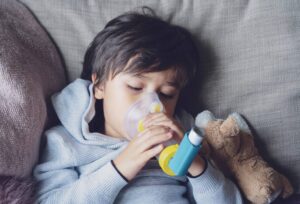Table of Contents
If your child is diagnosed with a food allergy, you have likely learned that this is not a simple or quickly managed medical problem, but rather a multifaceted and immersive lifestyle requiring vigilance from the entire family, both inside and outside the home. In the beginning, food allergies can feel overwhelming, but with time, your child and family will adjust and become experts in managing life with food allergies. Here are some ways to live and adapt to pediatric food allergies.
Find the Right Allergist
At the center of your child’s food allergy journey should be a high-quality allergist who can not only help with the diagnosis and treatment plan for your child, but also coordinate additional resources and professionals for comprehensive and holistic care. Getting an appropriate diagnosis can be a frustrating process, but an allergist will guide you through the process and which methods of diagnosis are best based on your child’s age, symptoms, and suspected number of allergies. The right allergist for your family should also be available and accessible in a format that works for you (like a telehealth allergist or virtual-first allergist), demonstrate competence with different cultures or family structures, and have quality of life at the center of their goals for your child’s treatment plan. They can help you navigate normal life experiences for children such as attending school and birthday parties, and can review treatment options to help you choose what fits your family best. Finding an allergist who feels like a trusted partner in your child’s care is one of the most important factors in living with food allergies and can help all the other things fall into place.
Work with a Nutritionist
Feeding children with food allergies can seem daunting, especially for those with more than one allergy. While grocery stores and the internet are full of alternative recipes and products, it can be infinitely helpful to have the expertise of a dietitian or nutritionist to help guide you and make meal planning suggestions. This not only takes some of the stress off of navigating what to serve, but also ensures that potential nutritional deficits are addressed and your child’s diet is as well-balanced as possible. Ideally, your dietician should be working alongside your pediatric allergist for the best care for your child. Just like your pediatric allergist, a dietitian should also be readily available and accessible in a format that works for your lifestyle, especially through telemedicine or telehealth allergy services, or some other source of virtual allergy care, to make it easier to get the services you need for your child. A collaborative multidisciplinary approach to your child’s allergy needs will produce better and long-lasting results.
Don’t Neglect Skin Care
While much conversation about food allergies centers around avoiding an anaphylactic reaction, the response to food allergens can be much more subtle and chronic. Particularly for babies and young children, food allergies may also appear as atopic dermatitis, or eczema. This uncomfortable allergic skin disorder and often widespread skin rash is the result of a disruption in the skin’s normal barrier, causing dry, cracked, itchy, red, and irritated skin. In addition to avoiding the causative food, a careful skin regimen to protect the skin’s moisture and avoid secondary infection of cracked, dry areas is necessary. If your child has food allergies and struggles with skin rashes, be sure to bring this up to their food allergist.
Learn to Read Labels
Reading food labels is an imperative skill when you have a child with food allergies. The Food and Drug Administration (FDA) does currently require any of the top 9 food allergens (milk, eggs, fish, crustacean shellfish, tree nuts, peanuts, wheat, soy, and sesame) to be clearly listed on ingredient lists or as a possible cross contaminant if made or packaged in the same factory. However, there are also alternative ingredients or “hidden” names that must be monitored for. For example, eggs may not be listed as an ingredient but rather egg-derivatives such as meringue, albumin, or mayonnaise. Soy can be found in ingredients such as tofu, edamame, or miso. Your child’s allergist or nutritionist can help guide you in what to look for on a food label to avoid accidental exposure to harmful foods.
Pay Attention to Mental Health
Living with food allergies is an all-encompassing journey, and so, special attention must be paid to a child’s mental health. Fear of an allergic reaction, disappointment over not being able to eat everything, frustration from missing out on things like birthday parties or eating at restaurants, or sensing stress in adults around them can lead to depression or anxiety in children. Appropriate allergy management should center around maintaining quality of life and allowing children to experience normal childhood experiences. If you suspect your child’s quality of life is suffering or they are experiencing symptoms of depression or anxiety, talk to their allergist about a referral to a mental health professional who can thoroughly assess and treat any issues that are present.
Explore Treatment Options
While avoiding food allergens and being prepared for a reaction is the gold standard of food allergy management, there are additional options available to provide some flexibility, reduce risk of serious reaction, and improve quality of life. Food immunotherapy is a developing treatment option that exposes your child to small but gradually increasing doses of their allergen in order to build up a tolerance in the body. Over time, this repeated exposure raises the amount of food that must be consumed before an immune system response is triggered, allowing some wiggle room with accidental exposures. Immunotherapy is available in a few different delivery methods, including oral, which can be a carefully measured powder or liquid mixed into applesauce or another small food serving; sublingual, which involves liquid drops placed under the tongue for fast absorption; or epicutaneous, which involves wearing a patch for 24 hours at a time for allergen exposure through the skin. Most of these methods are still in development; however, Palforzia, a powder (contained in a capsule), is an oral immunotherapy available to mitigate allergic reactions that can occur with accidental exposure to peanuts.
Plan for Emergencies
Anticipating and preparing for accidental exposures and emergencies will empower you and your child and avoid additional confusion or panic if a food reaction does occur. As a family, you should frequently review signs and symptoms of an allergic reaction, where EpiPens (epinephrine auto-injector for decreasing life-threatening allergic reactions) are kept, how to administer an EpiPen, and how to call 911. Remember that epinephrine is quick to wear off, but an allergic reaction can last much longer, so always call 911 or seek emergency services after using an EpiPen. Check the date on EpiPens periodically and replace them if expired. EpiPens should be kept in easily accessible and easy-to-remember locations throughout the house or in backpacks and purses when outside the house. For young children or those with multiple food allergies, an allergy alert bracelet may be a good idea.











